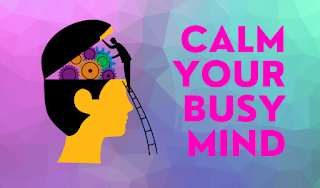Techniques to Calm a Busy Mind
My Mind Keeps Racing - Techniques to Calm a Busy Mind
A full mind needs mindfulness. When your mind is full and thoughts are just a whirlwind, it's hard to consider anything. Or does this happen once you attempt to nod off, thoughts won't leave you alone and you re-evaluate the day's events again and again?
Techniques to Calm a Busy Mind
Whatever the reason for your busy mind, mindfulness has some techniques to assist you to slow the race down and silence the clamor. The start line is usually bringing our focus to our breath, without judgment, without trying to vary the pattern of our breathing.
Let's explore a few situations and see if they ring true for you.
Can't sleep - mind too full
This is a really common scenario for several folks and that we all have our own ways of handling it. a number of us may 'start again' on the rituals of getting to bed, others folks may address a book or a hot drink. All of those are perfectly good approaches thereto a particular problem, but let's take a glance at a number of the mindful techniques that we will use.
Relaxing to travel to sleep may be a time once we can practice that specializes in our breath and body. Mindfulness meditation often begins with that specialize in the breath, in and out, without trying to vary it, just noticing the flow in and out. This awareness of our breathing may be a way of distracting ourselves from the whirl of thought. If we will bring our focus to the sensation of the breath occupation and out of our bodies, the increase and fall of the ribs, the texture of the air passing through the nose or mouth, then we will divert ourselves from that specialize in our thoughts. it's highly likely that originally we'll be unable to take care of specializing in our breathing and far away from our thoughts, but the more you practice, the better it becomes.
A meditation that's often helpful for calming the mind before sleep may be a visualization technique. this suggests we build an image in our minds of a scene. the image for this meditation may be a stream with leaves floating on its surface. The stream is flowing in order that the leaves can float past unimpeded. As we relax and specialize in our breath, we'll experience thoughts coming into our minds. As each thought appears, we take it and place it on a leaf and let it float away. the thought of this meditation is to encourage us to ascertain our thoughts as transient and to permit them to 'float away'. Sometimes this sort of meditation uses other imagery, clouds floating past, balloons floating away, but the concept is that the same, see your thoughts as transient and permit them to maneuver away. during this way, we will clear our minds and with a transparent mind, are ready to nod off.
Unable to focus - too many things on your mind
Often this example occurs once we are anxious, and it's going to feel completely disabling. We may find it hard to form decisions, or maybe simple choices. We are stuck in our habitual responses, frozen in time.
This, very brief, the practice provides how to exit of automatic pilot mode and into this moment. What we do is creating an area to reconnect together with your natural resilience and wisdom. We are simply tuning in to what's happening immediately, without expectation of any particular result. Its referred to as 'S.T.O.P.'
S - Stop and size up, checking in to go, heart and body.
We bring ourselves into this moment by deliberately asking - 'what is my experience right now?'
- Thoughts - what are we saying to ourselves, what images are coming to mind
- Feelings - enjoying, neutral, upset, excited, sad, angry, etc.
- Sensations - physical sensations, tightness, holding, lightness
We acknowledge and register our experience, albeit it's uncomfortable.
T - "Take" a breath and direct our awareness to our breathing.
Our breath can function as an anchor to bring us into this and help us tune into a state of awareness and stillness. Take a deep breath in and out. Then still breathe normally. we should always gently direct our full attention to breathing, to every in-breath and to every out-breath as they follow, one after the opposite.
O - Open and observe, expanding our awareness outward.
We expand the sector of our awareness around and beyond our breathing, in order that it includes a way of the body as an entire, our posture, and countenance, then further outward to what's happening around us: sights, sounds, smells, etc. it's going to be helpful to count - 4 things we will see, 3 things we will hear, 2 thing we will touch and 1 thing we will smell.
As best we will bring this expanded awareness to our next moments.
P - Proceed with new possibilities, continuing without expectation.
Next, we let our attention enter the planet around us, sensing how things are immediate.
Rather than react habitually or mechanically, we will be curious and open, responding naturally. we've broken the automated pilot response, without expecting a result.
Try and practice these techniques next time you discover yourself with a busy mind. Learn more...


No comments